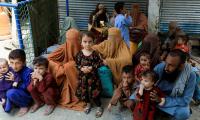Every winter, a thick layer of smog engulfs the Land of Five Rivers transforming our vibrant metropolises into a grey, choking haze. This annual catastrophe reminds us of the true cost of inaction – millions of lives, trillions of rupees, and around 7.0 per cent of Pakistan’s GDP lost to particulate matter.
While it is most visible in the winter, its roots run deep, intertwined with longstanding deficiencies in urban planning, industrial regulation, and agricultural practices. Temperature inversions, trap pollutants close to the ground, creating a deadly cocktail of toxins that silently lingers in the air. Smog isn’t merely an ‘environmental’ issue anymore; it is a public health emergency, a socioeconomic burden, and a human security issue.
In Punjab, over 11 million children endure life in one of the most polluted regions on earth, exposed to air quality index (AQI) levels as high as 1,900 – nearly 100 times the safe limits. Nasa’s satellites tell a similar story, with the OMPS Aerosol Index hitting as high as 4.5, with the maximum being 5, signaling an existential crisis.
Despite being a public good, clean air remains a classic case of the tragedy of the commons – a shared resource exploited without accountability. Smog is Pakistan’s ‘fifth season’ the ultimate equalizer that spares no one and graciously infiltrates lungs rich and poor alike. It levels the playing field, indiscriminating, uniting us all under this thick choking layer of soot and dust. Yet, we have failed to truly measure, assess, and manage the true cost of smog, a public health crisis.
The true cost of smog is vast and multifaceted, impacting health, the economy, society, and the environment. Health-wise, smog leads to respiratory and cardiovascular diseases, premature deaths, and cognitive impairments, overwhelming the healthcare system and reducing life expectancy.
Economically, it damages crops, reduces worker productivity, disrupts tourism, and strains energy systems, costing billions annually. Socially, smog exacerbates inequalities, disrupts education, and stifles human development by limiting mobility and well-being. Environmentally, it accelerates biodiversity loss, pollutes soil and water, and intensifies climate change.
These interrelated costs are just a glimpse of what is at stake, with estimates, or rather underestimates, incurring between $22 billion and $48 billion of air pollution-related costs to the Pakistan economy annually. Yet, authorities continue to downplay the crisis, reflecting this cognitive decay, a systemic failure of governance of the highest order.
What do we need to survive the smog crisis? A good lung capacity, sheer willpower, and, if one is lucky, a cup of chai to chase down that particulate matter. Rationally, a bankrupt nation under a green lockdown surely cannot afford such stopgap measures like cloud seeding, water sprinkling, smog-free towers, and air purifiers - all of which stand devoid of any long-lasting impact.
Achieving clean air demands a transformative, sustained set of actions rather than superficial fixes. These include holding industries accountable through penalties for emissions and incentivising cleaner practices to internalise environmental costs. A cleaner transportation future can be realised through improved public transit, cleaner fuels, and infrastructure for carpooling and biking.
Educating 240 million people on the fundamentals of smog, air quality, and climate is imperative. A combination of green tech accelerators that enable youth to develop innovative solutions, air quality research centres that generate critical data and insights, and early warning systems could also play a pivotal role.
Scaling up affordable and sustainable alternatives to stubble burning, such as Happy Seeders, along with the widespread adoption of zigzag technology in brick kilns across Pakistan, can enhance productivity while reducing emissions. Urban and industrial reforms – such as promoting urban forestry, transitioning to low-carbon energy, and improving waste management – can also significantly decrease the volatile organic compounds in the atmosphere.
Regionally, Pakistan should lead efforts for a South Asian Air Quality pact, a charter of clean air quality, while forming synergies to decarbonise our economies at an unprecedented scale. Nationally, strong governance, backed by technocratic leadership and an adequate share for nature in the national budget, is essential to turn these transmission channels into a cleaner, healthier reality for all.
It took Pakistan seven decades to register the devastating impacts of toxic air, and we surely cannot afford another seven to manage it. A staggering 98.3 per cent of the population now lives in areas where air quality exceeds the national standard of 15 g/m3. Alas, we now exist in a society where clean air has become a luxury, rather a basic right. It is evident that we have reached a tipping point, and must deliver, as the cost of inaction is too high, time too less, and impacts too grave.
The writer is an environmental economist and can be reached at: hashimzaman1@gmail.com
This demand has fueled rapid growth deposit base of Islamic Banks and Islamic Windows operated by conventional banks
But Punjab Agriculture Food and Drug Authority building near Thokar Niazbeg on Multan Road stands out
Macron has been particularly vocal in their criticism, asserting that withholding arms from Kyiv plays directly into...
As PPP governs province, Bilawal Bhutto Zardari holds strategic position to address both violence and its underlying...
Critics argue that strategy is vague, but closer look indicates strategic alignment with global trends and national...
To defeat it, we must distrust bot-driven narratives, to defeat it, we must verify sources before believing or sharing







